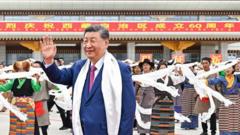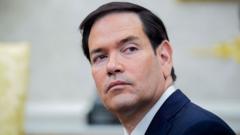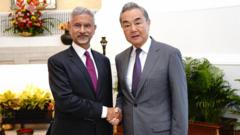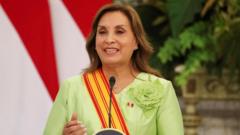Xi's visit marks a pivotal moment in China's relationship with the region, as he aims to reinforce authority while facing historical resistance.
**Xi Jinping Emphasizes Stability and Progress During Historic Tibet Visit**

**Xi Jinping Emphasizes Stability and Progress During Historic Tibet Visit**
In a significant address, China's President Xi Jinping champions unity and stability in Tibet amid ongoing tensions.
In a rare visit to Tibet, President Xi Jinping addressed a gathering of 20,000 in Lhasa, commemorating 60 years since the establishment of the region following its annexation by China. This occasion marked his second presidential trip to the heavily monitored area, where he praised local leaders for combating separatism, a clear nod to the continued Tibetan resistance against Beijing's governance. With health risks posed by the region's high altitude, his visit is interpreted as a move to assert control over Tibet.
Notably absent from Xi’s remarks was any mention of the Dalai Lama, who has resided in exile in India since fleeing Tibet in 1959. Xi stated, “To govern, stabilise and develop Tibet, the first thing is to maintain political stability, social stability, ethnic unity and religious harmony.” This statement arrives just two months post the Dalai Lama's declaration that his office, not the Chinese authority, would determine his successor, a claim contested by Beijing.
Despite China's assertions of improved living standards in Tibet, human rights advocates argue that Beijing is progressively eroding Tibetan cultural identity and freedoms. A recent investigation by the BBC at a Tibetan monastery highlighted claims of ongoing repression by the Chinese Communist Party (CCP).
Xi's surprise visit dominated state media, being portrayed as a festive engagement with the local population, with images of jubilant crowds and cultural performances adorning headlines. In discussions with CCP officials, he promoted economic, cultural, and linguistic collaboration while advocating for new educational laws mandating Tibetan children to learn Mandarin in state-run schools.
The visit coincides with the initiation of construction on the Motuo Hydropower Station, set to be the largest dam in the world, which has raised concerns regarding ecological impact and regional water control, particularly over the vital Yarlung Tsangpo river that flows into India and Bangladesh.
As Xi Jinping continues to pitch his vision for Tibet, balancing development with strict governance, he faces the enduring challenge of reconciling differing narratives and aspirations in the region.
Notably absent from Xi’s remarks was any mention of the Dalai Lama, who has resided in exile in India since fleeing Tibet in 1959. Xi stated, “To govern, stabilise and develop Tibet, the first thing is to maintain political stability, social stability, ethnic unity and religious harmony.” This statement arrives just two months post the Dalai Lama's declaration that his office, not the Chinese authority, would determine his successor, a claim contested by Beijing.
Despite China's assertions of improved living standards in Tibet, human rights advocates argue that Beijing is progressively eroding Tibetan cultural identity and freedoms. A recent investigation by the BBC at a Tibetan monastery highlighted claims of ongoing repression by the Chinese Communist Party (CCP).
Xi's surprise visit dominated state media, being portrayed as a festive engagement with the local population, with images of jubilant crowds and cultural performances adorning headlines. In discussions with CCP officials, he promoted economic, cultural, and linguistic collaboration while advocating for new educational laws mandating Tibetan children to learn Mandarin in state-run schools.
The visit coincides with the initiation of construction on the Motuo Hydropower Station, set to be the largest dam in the world, which has raised concerns regarding ecological impact and regional water control, particularly over the vital Yarlung Tsangpo river that flows into India and Bangladesh.
As Xi Jinping continues to pitch his vision for Tibet, balancing development with strict governance, he faces the enduring challenge of reconciling differing narratives and aspirations in the region.
















